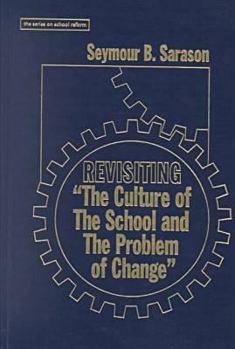Revisiting the Culture of the School and the Problem of Change
Select Format
Select Condition 
Book Overview
Revisiting "The Culture of the School and the Problem of Change" provocatively and seamlessly joins Seymour Sarason's classic, landmark text on school change with his own insightful reflections on those same issues in the face of today's crisis in public schools. This is an extensive, monograph-length revisiting. ;Part I of this book reproduces the second edition of Sarason's ground-breaking work, The Culture of the School and the...
Format:Hardcover
Language:English
ISBN:0807735442
ISBN13:9780807735442
Release Date:June 1996
Publisher:Teachers College Press
Length:398 Pages
Weight:1.35 lbs.
Customer Reviews
2 ratings
Revisiting "The Culture of The School/The Problem of Change"
Published by Thriftbooks.com User , 21 years ago
Reviewer: Phil H. Gropp from Omaha, NEDr. Seymour Sarason's book is divided into two main sections/parts. In the first section, he reproduces and elaborates on the second edition of his 1971 book, "The Culture of The School and The Problem of Change." The main thesis of the section was that of defining the organization and culture of a school and the attachments the school personnel have to their ways of working in that environment. His main argument was that both of these complex realities must be changed if real improvement is to take place. In the chapters of section one, Sarason expounds on three major themes/concepts: that school cultures are complicated, that principals and teachers are isolated in their position, and that teachers responsible for student achievement often have little time to learn new educational ideas. In concluding section one, Dr. Sarason stresses that changing a school culture is difficult work and must be done in a comprehensive way if it is to be effective and of lasting significance.In the second section, Sarason "REVISITS" his original thoughts and philosophy of changing school culture. He elevates his concerns of trying to maintain and improve public education as we have known it. Sarason states that "what happens in our cities and our schools will determine the fate of our society."The first of the two main points he "revisits" is that for the process of change to take place today, you must completely understand a school's culture especially its people, values, and practices. Secondly, for increased achievement to be envisioned, teachers must relinquish their total control over students and allow them to take more responsibility for (at least most of) their own learning.This book is a fascinating look at 20th century United States educational history. From the philosophy of pre-World War II educators, to the major Supreme Court decision dealing with desegregation, Sarason spins his challenging philosophy in a way that makes the reader establish attitudes about his/her educational convictions. With his knowledge of history, Sarason provides his opinions on what it will take for public education to flourish (or fail) in the 21st century. His visions of changing educational paradigms gives his work food for thought and interesting educational debate.
Sarason Revisited
Published by Thriftbooks.com User , 21 years ago
When Sarson first published his work 25 years ago, he was, without a doubt, far ahead of his time in his thinking about schools, teachers, principals, and the ability of the students to learn. He questioned the problems associated with the whole educational environment, and suggested such "outlandish" ideas such as de-emphasizing the teaching of reading and arithmetic in the early grades and eliminating the role of the school principal and the boards of education as they were then known (13). He judged the new math as being pretty dull and ineffectual. He relished giving teachers more control over their classroom environments. To emphasize his points, he referred to his man from outer space who frequently observed schools from a purely non-partisan role. For example, this spaceman would puzzlingly see schools filled five days a week, observe virtual bustling communities of activity, only to close down two days a week. He would then ponder better school scheduling and community involvement. Sarason took on the great educators of the time-names like Conant and Dewey, Koerner and Rickover, and offered sound proposals for the changing world that was profoundly influencing the school culture.But in his REVISITING section of the book, he offers his opinions on a gammed of subjects, including school organizations, teachers, students, vouchers, and social change, to name a few. One of his most fascinating points is that of reiterating the idea that schools need to create and maintain environments that are continually providing productive learning for students that allows "knowing" to become internalized. This book is a fascinating look at the past, as well as a glimpse at the present and future of education in the United States. Sarason provides the reader with an opportunity to examine the ideas he first propounded a quarter century ago, and to see how well they fit into the 21st century. His work is tremendously written, carefully crafted, and lovingly offered to the educator of today.





